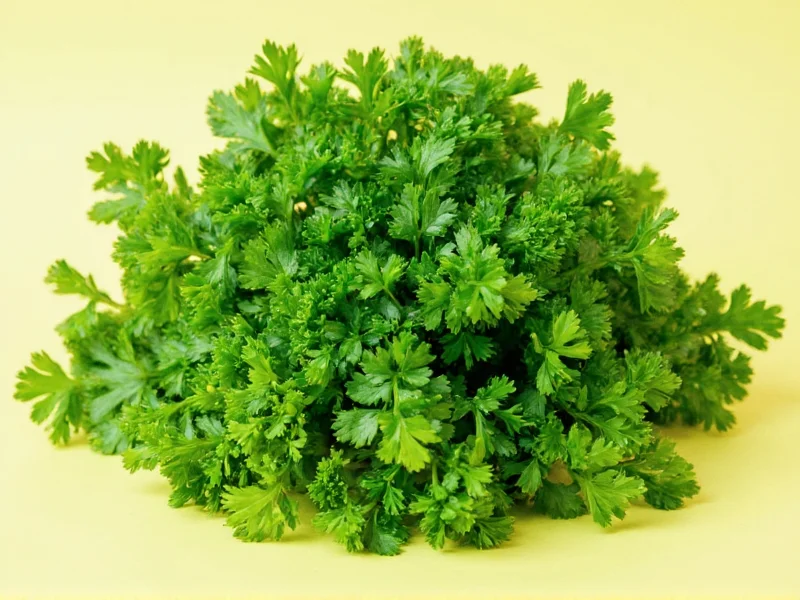Many home cooks and even experienced chefs encounter confusion about whether parsley and coriander are the same herb. This misunderstanding has persisted for years across different culinary traditions. Let's clarify this botanical mix-up with precise information that will help you confidently identify and use both herbs in your cooking.
Botanical Classification: Two Distinct Plants
Understanding the scientific distinction between these herbs eliminates the confusion immediately. Parsley (Petroselinum crispum) and coriander (Coriandrum sativum) belong to completely different plant families:
| Herb | Scientific Name | Plant Family | Native Region |
|---|---|---|---|
| Parsley | Petroselinum crispum | Apiaceae (same as celery) | Mediterranean region |
| Coriander | Coriandrum sativum | Apiaceae (same family, different genus) | Southern Europe/North Africa |
While they share the same plant family (Apiaceae), they're as different from each other as carrots are from celery. This botanical distinction explains why their flavors, growth habits, and culinary applications vary significantly.
Why the Confusion Exists: Regional Naming Differences
The primary reason people ask “are parsley and coriander the same” stems from inconsistent naming conventions across English-speaking regions:
- In the United States, coriander refers specifically to the dried seeds of Coriandrum sativum, while the fresh leaves are called cilantro
- In the UK, Australia, India, and many Commonwealth countries, the entire Coriandrum sativum plant (leaves and seeds) is called coriander
- Parsley maintains consistent naming globally, though there are different varieties (curly vs. flat-leaf)
This regional terminology difference creates significant confusion, especially when following international recipes. When someone in London asks for “coriander,” they mean the fresh herb Americans call cilantro—not parsley.
Visual and Sensory Differences: How to Tell Them Apart
Learning to distinguish parsley from coriander (cilantro) by sight, smell, and taste prevents recipe disasters. Here's what to look for when identifying these herbs:
| Characteristic | Parsley | Coriander (Cilantro) |
|---|---|---|
| Leaf Shape | Broad, ruffled edges (curly parsley) or flat, pointed leaves (Italian parsley) | Small, rounded, lacy leaves with scalloped edges |
| Color | Bright to deep green | Lighter, almost yellowish green |
| Aroma | Grassy, mild, slightly peppery | Strong citrusy scent with soapy notes (to some people) |
| Taste | Mild, fresh, slightly bitter | Pronounced citrus flavor with distinctive “cilantro soap” effect for some |
| Stem Texture | Thicker, more rigid | Thinner, more delicate |
Culinary Applications: When to Use Each Herb
Understanding the flavor profiles helps determine appropriate usage. Substituting one for the other dramatically alters dish outcomes.
Parsley serves as a versatile finishing herb with a mild flavor that complements rather than dominates. Chefs use it in:
- Mediterranean dishes like tabbouleh and gremolata
- As a garnish for soups, stews, and roasted meats
- In herb blends like fines herbes and persillade
- With fish, potatoes, and egg dishes where subtle flavor is preferred
Coriander (Cilantro) delivers a bold, distinctive flavor essential to specific cuisines:
- Mexican and Latin American salsas, guacamole, and ceviche
- Asian curries, particularly Thai and Vietnamese dishes
- Indian chutneys and raitas
- Middle Eastern dishes like falafel and toum
Attempting to substitute parsley for coriander in a Thai curry would result in a completely different flavor profile, while using coriander in a traditional Italian gremolata would overwhelm the delicate balance.
Genetic Factors in Perception: The “Soap Gene”
An interesting aspect of the coriander vs. parsley discussion involves genetic differences in taste perception. Approximately 21% of the population carries a genetic variant (OR6A2) that makes coriander taste like soap. This genetic predisposition doesn't affect parsley perception, creating another layer to the confusion when people describe “coriander” as having an unpleasant soapy flavor while parsley remains universally acceptable.
Growing Characteristics for Home Gardeners
If you grow your own herbs, understanding their different growing requirements prevents cultivation mistakes:
- Parsley is a biennial plant that prefers cooler temperatures, grows well in partial shade, and has a longer growing season. It's more cold-tolerant and can survive light frosts.
- Coriander grows quickly but bolts (goes to seed) rapidly in warm weather. It prefers full sun but needs cooler temperatures to prevent premature flowering. The seeds (coriander) develop after the plant flowers.
Attempting to grow “coriander” expecting it to behave like parsley—or vice versa—leads to disappointing harvests due to these fundamental growth differences.
Substitution Guidance: When You Can and Cannot Swap Them
While neither herb makes a perfect substitute for the other, understanding acceptable substitutions prevents recipe failures:
- Never substitute when the herb is the star ingredient (e.g., cilantro in salsa or parsley in Italian parsley pesto)
- Acceptable substitutions occur when the herb plays a supporting role in complex dishes with many ingredients
- For parsley substitution, try chervil or celery leaves for similar mild flavor
- For coriander substitution, consider Mexican oregano or a small amount of fresh basil with lime juice
Understanding the difference between parsley and coriander prevents culinary disasters and helps you follow international recipes accurately. Recognizing regional naming conventions—particularly that “coriander” means different things in different countries—resolves much of the confusion surrounding whether parsley and coriander are the same herb.











 浙公网安备
33010002000092号
浙公网安备
33010002000092号 浙B2-20120091-4
浙B2-20120091-4